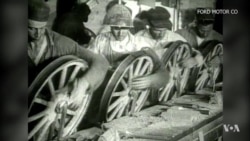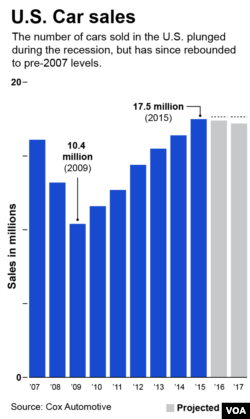Millions of workers in the U.S. alone are expected to face growing competition as computerized autonomous vehicles start to perform taxi and truck driving jobs.
While the takeover of trucking by computerized robots is considered inevitable, how soon it will happen is a matter of debate. Some say it will take years to fully develop. Others predict it will happen much sooner.
Massive, autonomous mining trucks move giant loads of earth and ore in Australia and elsewhere. The trucks are able to handle the very limited traffic seen in the mine, but the chaos of the open road will be a bigger challenge.
The head of engineering for the American Trucking Association, Ted Scott, says it will take time to work out regulations, testing and public acceptance. “With the technology that is there, we can take the driver out of the vehicle. We aren’t gonna do that for a long time."
Volvo and Uber have announced a plan to test self-driving cars in Pittsburgh, and Ford recently announced a joint research effort with a Chinese company to push self-driving vehicle technology forward. Audi and others are testing robot drivers in ever more complex environments, including Audi's race up a large American mountain and big city traffic.
A former official of the National Highway Traffic Safety Administration, Chan Leiu, says these tests may speed things up.
"We are not that far from the ultimate vision of a completely self-driving car," Leiu said, adding that autonomous vehicles literally put people’s lives in the hands of robots. But that may be a good thing because he says 94 percent of accidents are caused by people who are tired, drunk, texting, or making other mistakes.
This could save tens of thousands of lives, according to Notre Dame professor Tim Carone.
"There's a journey to get there, but the journey ends with [an] order of magnitude decrease in [the] number of accidents, number [of] fatalities, number of injuries," he said.
Human workers
Truck drivers, such as 16-year road veteran Rogelio Rada, think it will be quite a while before robots take their jobs.
“Robots can only do so much...there’s issues I believe that only a person can handle,“ Rada said.
His colleague, Barry Waters, thinks it will be "probably 20-30 years down the road."
Trucking employs as much as one percent of the U.S. population. The potential for changes in the industry follow decades of mostly declining human employment in U.S. manufacturing. The trend is evident in the auto industry, which sold a record number of vehicles in 2015, but did so with far fewer workers than it once employed.
Early in the age of autos, it took throngs of workers to build cars like the Model-T. Historic film shows waves of workers spilling out of factories at the end of their shift, where they did much of the work by hand with muscle power.
Competitive pressures forced manufacturers of all kinds to seek ever more efficient, less labor-intensive and cheaper ways to make products. Current video shows far fewer people on the factory floor as powerful robots weld, paint and preform other tasks, often with greater precision than their human predecessors.
Wondering about the future
Wondering about the future
Futurists try to predict how changes in the world will impact society.
- How will changing technology — better batteries, new materials, self-driving cars, new kinds of devices — change our lives?
- How will the sharing economy — shared cars and other resources — change the way we live and work?
- What will happen when the number of people over the age of 60 doubles?
What do you predict? What predictions do you have for the future? Share your ideas on Twitter #VOApredictions
Developing new skills
That is bad news for millions of workers like Holly Stover, who was laid off after years of work for steel firms.
“I hope I'll end up working a good, a decent job, making a decent living,” she said.
With help from an employment counselor, Stover is exploring new kinds of work and considering attending school to update her skills.
Georgetown University workforce expert Anthony Carnavale says more industrial robots means fewer humans have high-paying jobs on production lines.
"Probably 75 percent of the job loss is technology-based," Carnavale said. "Robots, machines in general, are substituting for people.”
New opportunities
But Deputy Secretary of Labor Chris Lu says the changing economy brings new opportunities for workers — if they have the skills. Employers complain they can’t find enough people who can run advanced machine tools or program computers.
“We've also, in this country, had a remarkable transition to a service economy and really wonderful high-paying jobs — in IT, for instance," Lu said. "That is an industry that didn't exist 20 or 30 years ago."
Meantime, the head of the Southeast Michigan Community Alliance, Greg Pitoniak, says his organization closely tracks the skills employers need and helps displaced workers meet those demands.
“Many job seekers look at it as, 'I can't afford to go to school for a couple years and not have an income,'" he said, explaining that employers are trying to close the skills gap by seeking apprentices for high-paying jobs like electrician, plumber, carpenter, millwright and pipefitter.
According to Pitoniak, the U.S. education system puts too much emphasis on college preparation and too little on getting people ready for technical jobs.
Prepping for the future
The changing skills needed from the work force, along with rapid changes in technology and fast-evolving consumer demands, present a major challenge for large manufacturers. It takes auto makers years to develop new products and efficient ways to build them.
In Dearborn, Michigan, the Ford Motor Company employs a futurist to draw a clearer picture of what is coming up. She makes illustrations and takes notes as she looks beyond the auto industry and wonders about the ever-more connected world, the growing middle class in emerging economies, expectations that technology will make life better, and environmental worries.
She considers the impact of new technologies, including making plastic car parts out of wheat straw, tomato stems, trees, soy beans, captured carbon dioxide, and all kinds of materials, instead of traditional petroleum. Parts made of alternative materials are sometimes lighter, which makes cars more fuel-efficient.
Sheryl Connelly says fuel-efficiency and sustainability are a growing challenge for auto manufacturers.
"As we add more and more people to the planet, consumption will have to be redefined, prosperity rethought," she said. "That is why we are moving toward the service-oriented, access oriented marketplace ... those people who can not afford a car still need mobility."
Environmentally-friendly shared ride services are under development by Ford and others. The company moves employees among its many facilities in an experimental shuttle service, controlled by a smart phone app. Shared vehicles could be a cheap alternative for emerging markets and an efficient one for crowded wealthy countries.
Some experts predict that shared vehicles, self-driving cars, and other changes could make more efficient use of vehicles and cut demand for cars.












